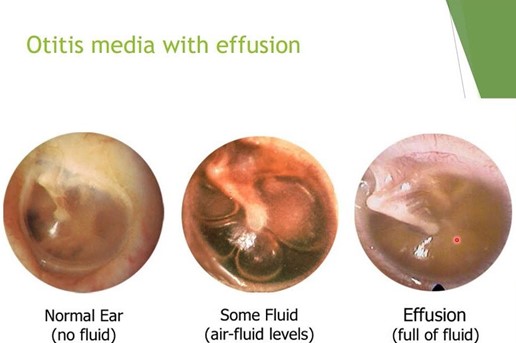A nurse is caring for a child who has otitis media with effusion. The nurse should identify which of the following manifestations indicates a tympanic membrane rupture.
Popping sensation when swallowing
Green-blue discharge in the ear canal
Sudden pain relief
Increased temperature
The Correct Answer is C
Choice A: A popping sensation when swallowing is not a sign of a tympanic membrane rupture, as it is a normal phenomenon that occurs when the eustachian tube opens and closes to equalize the pressure between the middle ear and the atmosphere. A popping sensation when swallowing may be associated with otitis media with effusion, which is a condition that causes fluid accumulation behind the eardrum, but it does not indicate a rupture.
Choice B: Green-blue discharge could be indicative of infection but is not as directly related to the rupture event as the sudden pain relief is.
Choice C: The correct answer is sudden relief of pain. This is because the rupture of the tympanic membrane releases the pressure and fluid that has built up in the middle ear, leading to an immediate decrease in pain.
Choice D: An increased temperature is not a sign of a tympanic membrane rupture, as it is a nonspecific symptom that may indicate various conditions, such as inflammation, infection, or fever. An increased temperature may be associated with otitis media with effusion, which is a condition that causes fluid accumulation behind the eardrum, but it does not indicate a rupture.

Nursing Test Bank
Naxlex Comprehensive Predictor Exams
Related Questions
Correct Answer is C
Explanation
Choice A: Reducing environmental stimuli can help decrease the discomfort and agitation of a child who has meningitis, as they may experience headache, photophobia, and neck stiffness. However, this action is not the priority, as it does not address the cause of the infection or prevent complications.
Choice B: Documenting intake and output can help monitor the fluid balance and hydration status of a child who has meningitis, as they may have fever, vomiting, and decreased oral intake. However, this action is not the priority, as it does not address the cause of the infection or prevent complications.
Choice C: Administering antibiotics when available can help treat the bacterial infection that causes meningitis and prevent serious complications such as brain damage, hearing loss, or death. This action is the priority, as it can save the child's life and improve their outcome.
Choice D: Maintaining seizure precautions can help protect the child from injury and provide safety measures in case of a seizure, as meningitis can cause increased intracranial pressure and seizures. However, this action is not the priority, as it does not address the cause of the infection or prevent complications.
Correct Answer is C
Explanation
Choice A: A popping sensation when swallowing is not a sign of a tympanic membrane rupture, as it is a normal phenomenon that occurs when the eustachian tube opens and closes to equalize the pressure between the middle ear and the atmosphere. A popping sensation when swallowing may be associated with otitis media with effusion, which is a condition that causes fluid accumulation behind the eardrum, but it does not indicate a rupture.
Choice B: Green-blue discharge could be indicative of infection but is not as directly related to the rupture event as the sudden pain relief is.
Choice C: The correct answer is sudden relief of pain. This is because the rupture of the tympanic membrane releases the pressure and fluid that has built up in the middle ear, leading to an immediate decrease in pain.
Choice D: An increased temperature is not a sign of a tympanic membrane rupture, as it is a nonspecific symptom that may indicate various conditions, such as inflammation, infection, or fever. An increased temperature may be associated with otitis media with effusion, which is a condition that causes fluid accumulation behind the eardrum, but it does not indicate a rupture.

Whether you are a student looking to ace your exams or a practicing nurse seeking to enhance your expertise , our nursing education contents will empower you with the confidence and competence to make a difference in the lives of patients and become a respected leader in the healthcare field.
Visit Naxlex, invest in your future and unlock endless possibilities with our unparalleled nursing education contents today
Report Wrong Answer on the Current Question
Do you disagree with the answer? If yes, what is your expected answer? Explain.
Kindly be descriptive with the issue you are facing.
